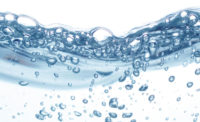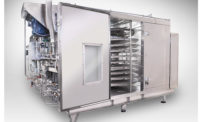Water management systems a key element in snack, bakery success
Efficient delivery and use of water, management and treatment of wastewater among goals




Snack food and bakery facilities need to efficiently deliver water for sanitation and cleaning tasks, using just the right amount, while reusing what they can. They also often need to manage, treat and/or recover wastewater, maintaining peak sanitary standards and food safety—including proper placement of drains—to help save time and money.
Best practices
Snack and bakery facilities should establish a water budget for each plant, says Bret Zaher, regional manager, food safety services, AIB International, Manhattan, KS. “Specifically, we want to know how much water is used per unit of production. And then one of the other things we encourage is upgrading old processing equipment.” This could include old boilers, clean-in-place (CIP) systems and other equipment that might not be as efficient with water usage. He likewise recommends installing low-flow nozzles on hose drops.
For the efficient delivery and use of water, Zaher recommends ensuring water is only used where it needs to be, such as the wash pit and mixing areas. “One of the big things we look for is making sure that no leaks, drips or condensation are occurring,” he says. “Many bakeries are very old, and delivery wasn’t designed in the most-efficient way.”
Zaher suggests potentially reusing water for agricultural purposes, including on surrounding landscape areas like lawns and for nonedible plants. “Some facilities will reuse water in toilet applications, for flushing,” he says. “You can’t recycle it—you can’t do a whole lot with graywater—without doing a full treatment. But you can use it for landscaping purposes and things like that.”
Other bakery sanitation procedures offer potential opportunities for getting more out of water usage. “A lot of bakeries will load up their mixer, let the water agitate for some time, and then dump it on the floor to get big particles off,” says Zaher. Capturing and repurposing the water from CIP units can likewise help with floor cleanup.
In treating bakery wastewater, Ecologix Environmental Systems, Alpharetta, GA, notes that facilities often need to deal with suspended solids, fats, oil and grease (FOG), as well as a high biochemical oxygen demand (BOD), a complex situation that requires a multi-step solution.
This starts with pretreatment to remove large solids, like gloves and hairnets, which might have fallen into the mix. Chemical treatment is needed to break down the FOG and ultimately form a sludge that can be settled or floated out of the water.
The next challenge: reducing the BOD to within effluent permit limits and to keep equipment and processing lines clean and disinfected.
“With bakeries and such, what we’ve learned is that the in-front wastewater is loaded with all sorts of things beyond what it should have,” says Eli Gruber, CEO, Ecologix. “Our experience shows that everything under the sun is being washed down the drain, including hair screens and gloves… That would be the first best practice, upstream, that every facility should take the initiative to do: Stop these things from entering the pit.”
Snack and bakery facilities should ensure they’re using environmentally friendly wastewater treatment systems and avoiding disinfecting chemicals that inhibit microbial growth, such as quaternary ammonium compounds—or “quats” for short. “There are a number of other disinfectants that would be more environmentally friendly,” says Gruber.
To maintain peak food safety and sanitary standards, Zaher recommends portable steam units that kill bacteria and “loosen up sugar debris and hard, baked-on stuff,” and which also reduce a plant’s water bill. Machines that employ dry ice and ice pellets can be similarly used for cleanup. Also, a lot of chemical contractors have great units that wash and sanitize in the same unit, he notes.
Drain details
When it comes to drains, Zaher says the most-common issue is they’re in the wrong spot. “A lot of my plants are plugging them up, so they don’t have to use them anymore,” he says. “Or they were ineffectively mapped. You need to know where you need a drain and slope the floor properly.” Sometimes in older bakeries, he adds, drains are higher than sections of the floor, which means water needs to be shoveled toward them.
The other problem is when plants are refurbished with new equipment—but the new equipment ends up over a drain, and it’s not properly sealed, which leads to harborage of bacteria and/or pests. “With a mixer right on top of a floor drain, that breeds slime, mold and pests, and you get potential Listeria. You need to make sure you know where you’re going to be using water on a regular basis.”
Blucher USA, Spindale, NC, a division of Watts Water Technologies, offers a drain series called the HygienicPro that helps bakeries and other food facilities keep their factory floors free of pooling water, says Walt See, regional sales manager. “We have a patented design that gets water out to the drain fast,” he says. “Anything that falls into the trench in the drain itself goes straight down to the bottom-center.”
The company’s stainless steel drains decrease the amount of water needed to clean the facility because the high velocity pulls waste from food scraps down the drain right away, notes See. Stainless also has greater resistance to biofilm formation from bacteria that can grab onto porous areas in other drain and piping materials like cast iron or PVC.
Floors in wet-wash areas need a bit of slope to aid with water drainage. But Blucher generally suggests that bakeries and other facilities not slope their floors too precipitously toward the drain in a food processing area to prevent safety concerns—and the higher costs of increasing the grade, notes See. “The lower grade allows for rolling carts, and forklifts, and decreases the potential for safety concerns,” he says.
Looking for a reprint of this article?
From high-res PDFs to custom plaques, order your copy today!







